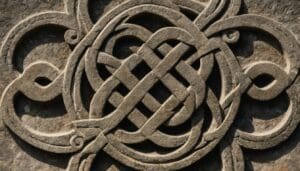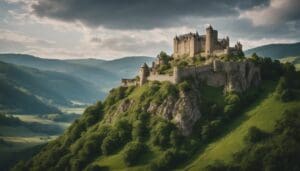Amazing Bushmills, Causeway Coast, County Antrim – 3 Top Attractions
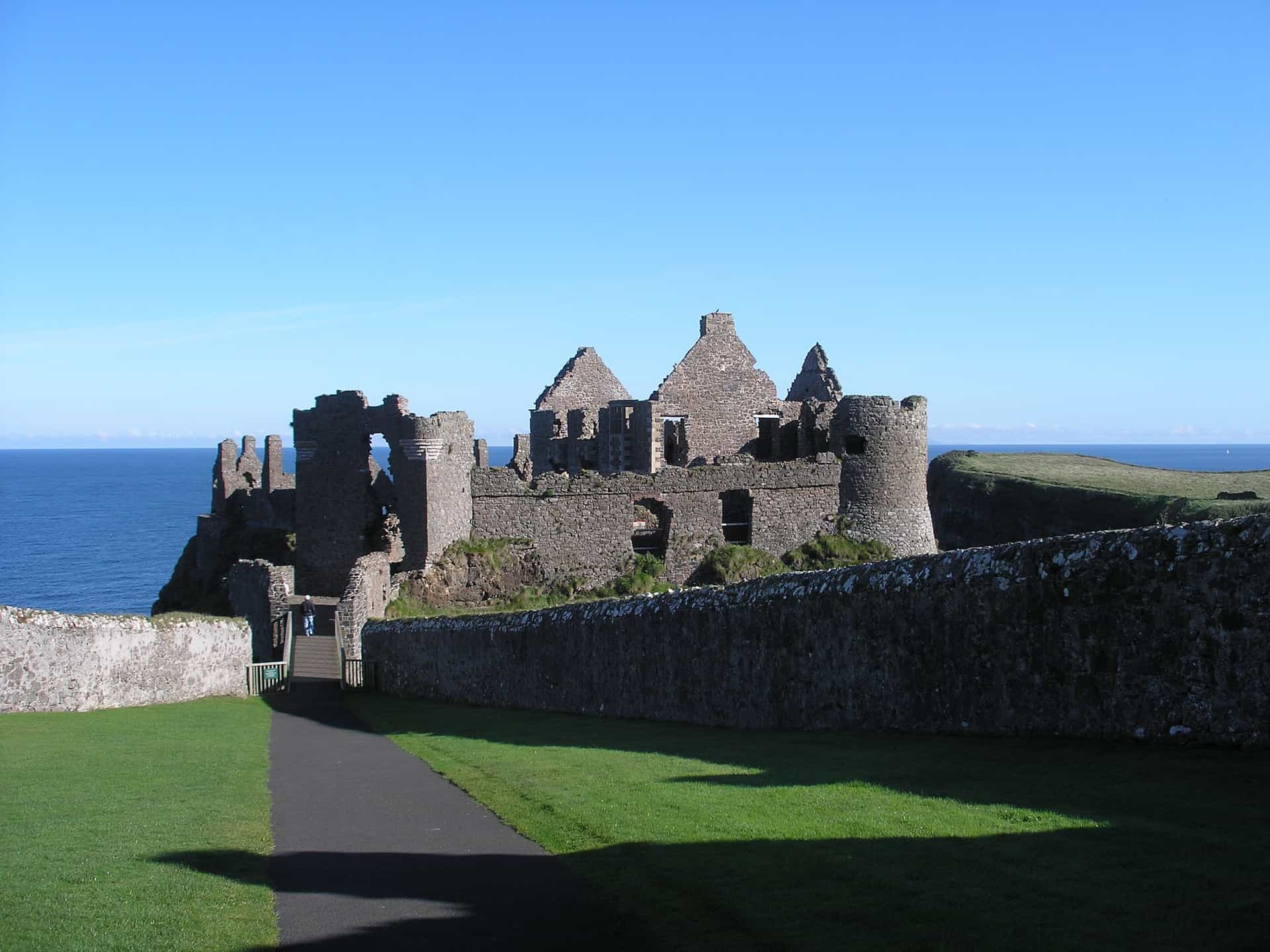
Updated On: April 07, 2024 by Asmaa Alhashimy
In the picturesque landscape of County Antrim, Northern Ireland, lies the enchanting village of Bushmills, which captivates the imagination with its rich tapestry of history, folklore, and natural wonders. Bushmills, renowned globally for its namesake distillery, is a destination transcending mere geographical boundaries; it’s a sanctuary where time seems to slow, and the whispers of the past echo through every cobblestone street.
As one ventures into this idyllic corner of the world, they are greeted by a sense of tranquillity that permeates the air—a tranquillity that belies the vibrant energy pulsating beneath the surface. For Bushmills, it is not merely a place frozen in time; it’s a living, breathing testament to the resilience of the human spirit and the enduring allure of the Irish landscape.
In this exploration, we embark on a journey to uncover the crown jewels of Bushmills, delving deep into its heart to unearth three top attractions that define its essence. From the historic distillery that birthed a legacy of craftsmanship to the rugged coastline where myth and geology intertwine and the ancient ruins that stand as silent sentinels of bygone eras, each destination beckons travellers with promises of adventure, discovery, and unforgettable experiences.
Join us as we traverse the cobbled streets, traverse the windswept cliffs, and immerse ourselves in the timeless charm of Bushmills and its surrounding wonders. For within its embrace lies a world of enchantment waiting to be discovered—a world where the past meets the present, and every moment is infused with the magic of Ireland’s Causeway Coast.
Table of Contents
Bushmills
Bushmills is a village on the north coast of County Antrim, Northern Ireland. During the 17th century, it was named after the mills on the River Bush. Which many will know is also given to Ireland’s oldest whiskey brand. It’s a unique conservation village on the Causeway coast and close to many notable landmarks such as The Giants Causeway, Dunluce Castle, and the Old Bushmills Whiskey Distillery. Known initially as Portcaman, the village dates back to the Norman era (1150-1520).
History
The first known record of the village was in William Boyd of Dunluce’s will, which dates back to 9 December 1624. The will essentially permitted John Logan to erect a mill, which was established in 1608. When Dunluce Castle and the nearby village came to ruin and became abandoned in the mid-1600s, the Dunluce and Portcaman parishes merged.
The Macnaghten family of Dundarave was responsible for building a market, hotel, courthouse, grain store and numerous houses in 1828. Sir Charles Lanyon built their estate house, which was initially called Bushmills House, but was changed in 1847 to Dundarave.
Further additions to Bushmills town by the Macnaghtens, including a town square, added to the market and a new bridge built in 1840. These improvements increased the population by 1891 to just over 1000 persons. Numerous mills were also built along the River Bush and the Bushmills Distillery. With the development of the Giant’s Causeway in the 1700s, Bushmills began welcoming more and more visitors.
In 1883, the world’s first hydroelectric railway began operating from Bushmills to the seaside resort of Portrush.
Dunluce Castle
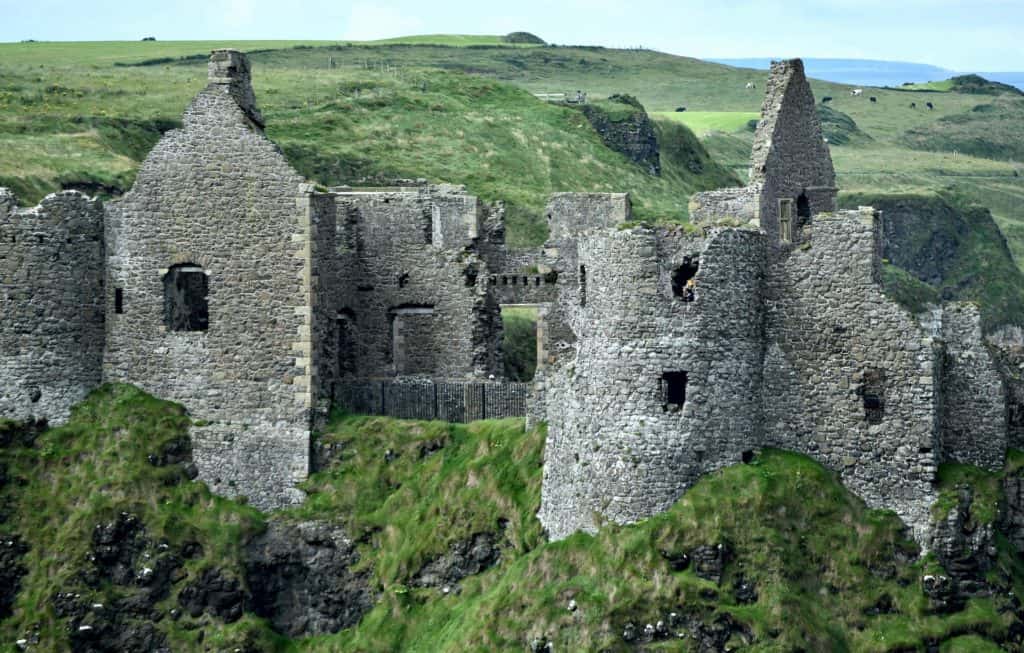
Dunluce Castle, near Bushmills, is a medieval castle in Northern Ireland, County Antrim. The castle is surrounded by very steep drops on each side, drawing the early Christians and Vikings to where an early Irish fort once stood. The castle is under the care of the Northern Ireland Environment Agency.
History
In the 13th century, Richard Óg de Burgh, the 2nd Earl of Ulster, built the first castle at Dunluce. Historical resources first document the castle in 1513in the hands of the McQuillan family. The McQuillans were the Lords of Route from the 13th century until they lost two major battles against the MacDonnells during the 16th century.
Situated one hundred feet above the ocean, Dunluce Castle was the seat of the chief of Clan MacDonnell of Antrim and the Clan MacDonald of Dunnyveg. In 1584, the Sorley Boy MacDonnell seized the Antrim Glens, swearing allegiance to Queen Elizabeth I, and consequently, his son Randal was made 1st Earl of Antrim by King James I.
Four years later, a ship from the Spanish Armada, dubbed the Girona, was shipwrecked on the rocks nearby. The ship was taken apart as the cannons were installed in the gatehouses, the rest of the cargo was sold, and the funds were used to restore and expand the castle.
Although the castle dates back to the 13th century, a souterrain was discovered 1,500 years ago.
The Importance of Dunluce Castle
This historic castle has been the site of numerous battles; over a one-hundred-year period, it was besieged multiple times. It is also a location of many legends. A local legend states that at one point, part of the kitchen next to the cliff face collapsed into the sea.
According to a widely known legend, when the kitchen collapsed, only a kitchen boy survived the crash, as he was sitting in the only corner of the kitchen that did not collapse. However, the kitchen is still intact and next to the manor house. You can still see the oven, fireplace, and entryways in it. It wasn’t until sometime in the 18th century that the north wall of the castle building collapsed into the sea.
Another story revolves around Maeve Roe, whom her father locked away in the castle’s north-eastern tower for refusing to marry her suitor. However, she managed to escape with her true love and fled to Mermaids Cave, where they fled by boat but were dashed against the cliffs. Maeve’s ghost is still said to sweep her prison tower.
Another legend involves the MacDonnells, who, after their expulsion, besieged the castle more than once until their forces climbed into the corner towers and hanged the English captain. His ghost is said to haunt a tower.
More about Dunluce Castle
Dunluce Castle served as the seat of the Earl of Antrim until 1690. Afterwards, the castle fell into ruin.
In 2011, archaeological excavations in the area discovered the remains of the Dunluce town near Bushmills, which was destroyed during the Irish uprising of 1641.
The town was built in 1608 by Randall MacDonnell, the first Earl of Antrim. It may have contained the innovative housing in Europe during the early 17th century, which included indoor toilets, which had barely been introduced in the rest of Europe then, and a complex street network based on a grid system. Visitors can explore the cobbled streets, a Scottish merchant’s house, a blacksmith’s forge, a courthouse, and a dungeon. There is also plenty of evidence of wealth and luxury, including coins from the period of Elizabeth I and Charles I.
One of the iconic historical figures linked to the castle is Winston Churchill, who once owned the estate, and it passed on to his family.
The castle has inspired many literary works over the years, including the orchestral tone poem Dunluce (1921) by Irish composer Norman Hay, and it is also thought to be the inspiration behind Cair Paravel in C. S. Lewis’ Chronicles of Narnia (1950–1954). The castle is also the subject of a 1990s song, “Dunluce Castle”, written by George Millar and sung by the Irish Rovers.
The Dunluce Castle has also been featured in the HBO hit drama series Game of Thrones, doubling as the stronghold of Pyke on the Iron Islands.
Giants Causeway
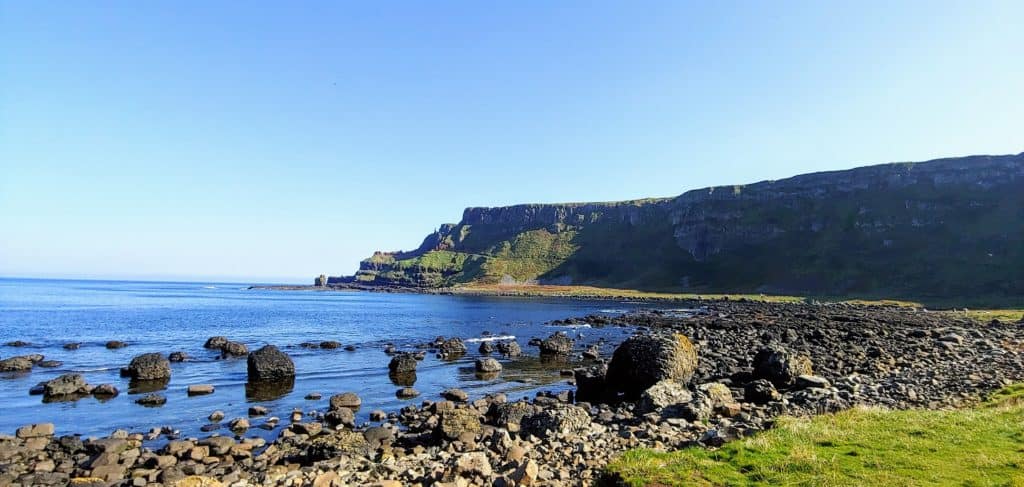
The world heritage site, the Giants Causeway, is another attraction near Bushmills. It’s the most visited attraction in Northern Ireland due to its unique landscape of rock formations. As well as the impressive views one can see while they are there. You can visit the visitor centre here to learn more about the history.
Old Bushmills Distillery
The Bushmills Distillery is a fabulous location to tour if you’re a fan of whiskey or not! It is considered one of the oldest working distilleries in the world. You can take a guided distillery tour, including a whiskey tasting and workshop. It also has a fantastic gift shop with exclusive Bushmills merchandise and more.
Conclusion
In the embrace of County Antrim’s rolling hills and rugged coastline lies a gem unlike any other – the village of Bushmills. As we conclude our journey through this enchanting corner of the world, we are left with a profound appreciation for its timeless magic and enduring allure.
From the storied halls of The Old Bushmills Distillery to the majestic splendour of the Giant’s Causeway and the haunting beauty of Dunluce Castle, Bushmills and its surrounding attractions offer a glimpse into the soul of Ireland’s Causeway Coast. Here, history whispers through ancient stones, myths dance upon the waves, and nature paints a masterpiece that defies comprehension.
But beyond the tangible treasures that await the intrepid traveller, the spirit of Bushmills truly captivates the heart. It is the warmth of its people, the sense of community that permeates its streets, and the undeniable sense of belonging that one finds in its embrace.
As we bid farewell to Bushmills, we carry memories that will linger long after our footsteps have faded from its shores. Yet, we also carry a promise – a promise to return- to lose ourselves again in this extraordinary place’s timeless magic.
So, until we meet again, may the spirit of Bushmills guide our journeys and remind us of the beauty waiting to be discovered in every corner of the world.
Have you been to any of these attractions in Bushmills? We would love to hear your experiences.
Also, check out some of our other blog posts that might interest you: Causeway Coast Trip, Giants Causeway Tour, Best Attractions in Northern Ireland, Where is Game of Thrones Filmed, The Legend of Finn Macool.


